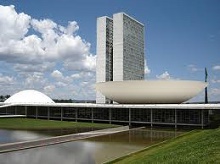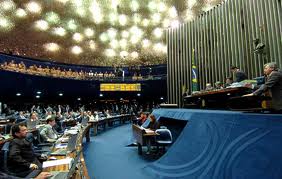Brazilian Government-Federal
 The Brazilian federation constituted, already in 1891, an old aspiration of the political elites as a form of accommodating and generating important economic and regional diversities. Consecrated in the first republican Constitution, in accordance with the North-American model, the federation, in practice, implied excessive autonomyy of state governments, which rapidly consolidated themselves as political oligarchies. The dispute for federal resources became, in time, a conflict between states, which did not feel embarrassment in using federal forces, momentarily under their control, to oust enemies in control of other states. However, this arrangement would only be broken when a dissension reached the criteria for the occupation of the Presidency of the Republic. A coalition of state forces unsatisfied with the result of presidential elections was the main agent of the 1930 Revolution, which would suspend for over 15 years states' autonomies.
The Brazilian federation constituted, already in 1891, an old aspiration of the political elites as a form of accommodating and generating important economic and regional diversities. Consecrated in the first republican Constitution, in accordance with the North-American model, the federation, in practice, implied excessive autonomyy of state governments, which rapidly consolidated themselves as political oligarchies. The dispute for federal resources became, in time, a conflict between states, which did not feel embarrassment in using federal forces, momentarily under their control, to oust enemies in control of other states. However, this arrangement would only be broken when a dissension reached the criteria for the occupation of the Presidency of the Republic. A coalition of state forces unsatisfied with the result of presidential elections was the main agent of the 1930 Revolution, which would suspend for over 15 years states' autonomies.
From 1946 on, and until today, the Brazilian federation is a controversial political-institutional aspiration, always having to face periodic cycles of concentration of attributions in the Presidency of the Republic. The 1988 Constitution destroyed the fiscal basis of Brazilian centralism, but from the political point of view, it is arguable that the federation had fixed itself on a stable model.
Constitutions:
Brazil has had, since its independence, seven Constitutions, with the following promulgation years: 1824, 1891, 1934, 1937, 1946, 1967 and 1988.
1824: the constitutional monarchy established in Brazil, together with the censual vote and the creation of the moderating power as a political instrument of the monarch's interference in the government's formation and in the legislative process.
1891: the federalism and president ship established in accordance to the North-American model, and strictly liberal formulation adopted, in terms of the definition of individual and social rights. The vote was, in principle, universal, but it excluded the illiterate population, and the bureaucratic impediments restricted the power of the universality principle.
1934: a Constitution which should re-democratise the country after the 1930 Revolution, the Charter of 34 is marked by the rupture with the liberal traditions in terms of social rights and the State's intervention in the economy.
1937: document which marks the implantation of the Estado Novo's authoritarian regime, under strong fascist inspiration. Its dispositions contained, however, an extensive roll of social and labour rights, within the corporatist conception.
1946: Constitution that inaugurates the first effectively democratic experience of Brazil's history, in establishing the legal basis of the bill of rights, and in conferring independence to the Legislative and Judiciary powers. It did, however, maintain some of the Estado Novo's distinctive traces, such as the corporatism.
1967: document via which the military regime initiated in 1964 tried to institutionalise itself. In it, is outstanding the concentration of powers in the hands of the Executive, even more aggravated by the Constitutional Amend nº 1, of 1969.
1988: this Charter established the legal parameters of the democratic regime initiated in 1985. It is innovative in its definitions of human and collective rights. It is marked by its extension and by the ridiculous character with which it establishes the social rights and regulates the economic order. It promotes a transfer of tributary revenues to the federation states without precedents in the country's history.
First Republic:
The Republic was born of a Coup d'Etat, supported by a heterogeneous and little cohesive alliance between positivist military officers, land proprietors and radicalised sectors of the urban intellectuality, which saw themselves badly represented in the Empire's power structure.
The Republic represented, with the establishment of Federalism by the Charter of 1891, a substantial increase in the political autonomy of the states' elites, a demand that existed since the Empire, and especially since the Republican Party's manifest, in 1870. The First Republic's political order was consolidated during Campos Sales' Presidency (1898-1902), by means of a pact between the states' elites and the national Executive's leader, by which, in exchange for the non-federal interference in the states' internal affairs, their representations in the Congress should obey presidential orientations. In the short and medium term, the pact resulted in the formation of only one party in each state, and in the stability of the national Executive power's exercise.
The political oligarchies of the states were connected to the interests of the exporting agrarian system, especially to coffee, in São Paulo, Minas Gerais and Rio de Janeiro, and to sugar, in the Northeast. With the rapid development of São Paulo's coffee-growing economy, oligarchies consolidated their power a federal level. São Paulo's national hegemony in the national ground ended by creating inter-oligarchic conflicts, which became critical in the 20s and culminated in the 1930 Revolution, ending the First Republic.
To visit the Brazilian Government website click here: http://www.brasil.gov.br/
Brazilian Parliament
Brazilian Senate
Ministry of External Rel.
Twitter
Tourism Information-MoT














